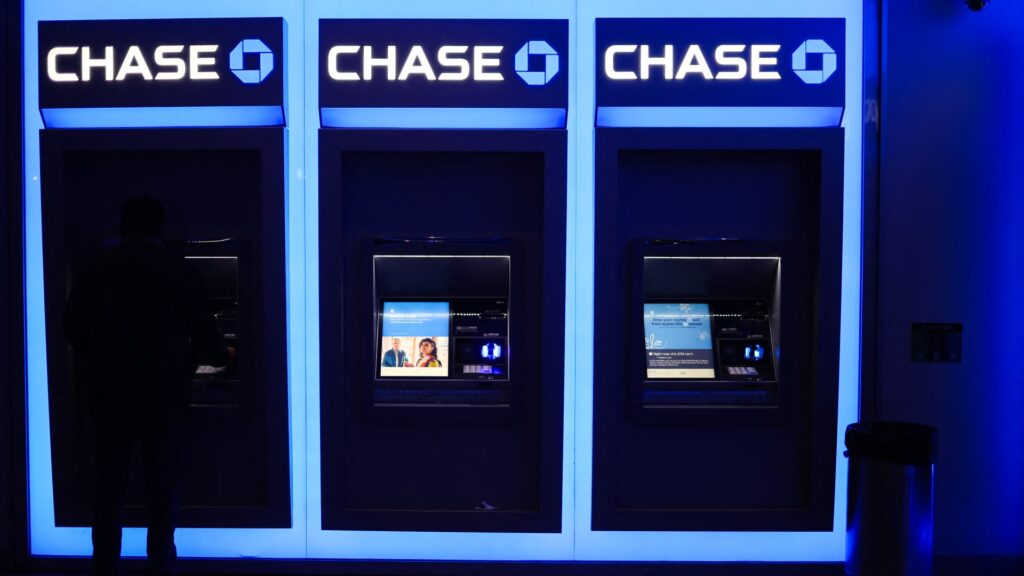
JPMorgan Chase Infinite Money Glitch: Bank Expands Lawsuits to State Courts
JPMorgan Chase Infinite Money Glitch: Bank Expands Lawsuits to State Courts
A customer uses a Chase ATM in New York City. The JPMorgan Chase infinite money glitch allowed customers to withdraw funds from fraudulent checks before they bounced. Photo: Charly Triballeau | AFP | Getty Images
Table of Contents
Introduction: JPMorgan Chase Infinite Money Glitch Lawsuits Expand
JPMorgan Chase has intensified its legal pursuit of customers who allegedly exploited the now-infamous “infinite money glitch” that went viral in late August 2024. The JPMorgan Chase infinite money glitch, which allowed customers to withdraw the entire value of fraudulent checks before they bounced, has now prompted the nation’s largest bank to file lawsuits in state courts against individuals who allegedly stole amounts below $75,000.
This expansion of legal action marks a significant escalation in the bank’s efforts to recover funds and deter similar exploits in the future. Previously, JPMorgan had focused on federal cases targeting customers who had allegedly stolen larger amounts through the banking vulnerability. Now, the bank is casting a wider net, filing complaints in state venues across Georgia, Miami, the Bronx in New York, and multiple counties in Texas.
Key Facts: JPMorgan Chase Infinite Money Glitch
- Timing of exploit: Went viral in late August 2024
- Nature of glitch: Allowed withdrawal of funds from fraudulent checks before they bounced
- Federal cases: Initially focused on amounts above $75,000
- New state cases: Targeting amounts below $75,000
- Recovery letters: Sent to more than 1,000 customers since October 2024
- Legal venues: Cases filed in Georgia, Miami, New York, and Texas
How the Chase Infinite Money Glitch Worked
The JPMorgan Chase infinite money glitch exploited a vulnerability in the bank’s check-processing system. The scheme, which spread rapidly through social media platforms in August 2024, worked through a relatively simple but effective process:
- Fraudulent deposit: A customer would deposit a check that they knew would eventually bounce
- Immediate access: Due to the glitch, the funds would be immediately available for withdrawal
- Quick withdrawal: Before the check could bounce and be flagged as fraudulent, the customer would withdraw the full amount in cash
- Multiple transactions: In many cases, perpetrators made multiple withdrawals at different branches to avoid detection
- Fund transfers: Some customers transferred money to third-party services like Cash App to further obscure the trail
This exploitation of the JPMorgan Chase infinite money glitch represented a modern version of classic check kiting fraud, but with digital banking vulnerabilities creating a more efficient mechanism for theft. The bank has since addressed the technical flaw that allowed the withdrawals, but is now focused on recovering the fraudulently obtained funds.
Recent State Court Cases and Examples
As the JPMorgan Chase infinite money glitch lawsuits expand to state courts, several cases highlight the bank’s approach to pursuing those who allegedly exploited the vulnerability:
Georgia Case Study
On Tuesday, April 16, 2025, JPMorgan Chase filed a lawsuit in Gwinnett County, Georgia, alleging that a customer orchestrated a sophisticated scheme to defraud the bank. According to court documents:
- “On August 29, 2024, a masked man deposited a check in Defendant’s Chase bank account in the amount of $73,000.00.”
- Within six days, before the check bounced, a series of cash withdrawals totaling $82,500 had been made at two Chase branches in Georgia.
- The defendant allegedly owes the bank $57,847.69 and has not complied with requests to return the funds.
Similar JPMorgan Chase infinite money glitch cases have been filed in multiple jurisdictions. The bank appears to be targeting cases with the clearest evidence of deliberate fraud, particularly those involving:
- Multiple withdrawals across different locations
- Attempts to conceal identity (such as wearing masks)
- Rapid withdrawal of funds immediately after deposit
- Transfers to third-party payment apps
- Failure to respond to the bank’s demands for repayment
These state-level lawsuits represent just one facet of JPMorgan’s multilayered approach to addressing the widespread exploitation of the banking vulnerability.
JPMorgan’s Fraud Recovery Strategy
JPMorgan Chase has implemented a comprehensive strategy to recover funds stolen through the infinite money glitch. According to sources familiar with the bank’s deliberations, the institution examined thousands of potential cases before selecting those with the largest amounts and clearest patterns of theft for litigation.
The JPMorgan Chase infinite money glitch recovery efforts include:
| Recovery Method | Implementation | Target Audience |
|---|---|---|
| Demand Letters | More than 1,000 sent since October 2024 | All identified customers who exploited the glitch |
| Federal Lawsuits | Filed in late 2024 | Cases involving more than $75,000 |
| State Lawsuits | Beginning April 2025 | Cases involving less than $75,000 |
| Bankruptcy Challenges | Motions filed in bankruptcy courts | Customers attempting to discharge debts through bankruptcy |
| Law Enforcement Cooperation | Ongoing | Support for potential criminal prosecutions |
“We’re still investigating cases of fraud and cooperating with law enforcement — and we’ll do that for as long as it takes to hold fraudsters accountable.”
— Drew Pusateri, Spokesman for JPMorgan Chase
These efforts demonstrate the bank’s determination to recover stolen funds and send a strong message that exploiting the JPMorgan Chase infinite money glitch will have serious consequences. Sources indicate that some customers have voluntarily returned funds after media coverage of the initial lawsuits, suggesting that the bank’s aggressive stance may be having a deterrent effect.
Combating Bankruptcy as a Shield
In a notable development, JPMorgan Chase is taking steps to prevent customers who exploited the infinite money glitch from using bankruptcy as a shield against repayment. The bank has begun filing motions in bankruptcy courts to ensure that debts incurred through the alleged fraud cannot be discharged through bankruptcy proceedings.
In one such motion filed this week in bankruptcy court in Grand Rapids, Michigan, JPMorgan requested additional time to object to a customer’s attempt to discharge their debts. According to court documents, the bank described itself as the “holder of an unsecured claim” resulting from “actions taken by the Debtor to deposit a fraudulent check in the amount of $44,779.46 to which the Debtors immediately made numerous cash withdrawals on August 30, 2024 as well as various Cash App transactions to himself.”
“There are genuine and important reasons people use bankruptcy protections. Getting rid of debts you accumulated through fraud isn’t one of them.”
— Drew Pusateri, Spokesman for JPMorgan Chase
This stance on bankruptcy highlights the seriousness with which JPMorgan is pursuing the JPMorgan Chase infinite money glitch cases. The bank is leveraging existing legal protections that prevent the discharge of debts incurred through fraudulent means, potentially closing a loophole that some perpetrators may have hoped to exploit.
Impact on Banking Industry Security
The JPMorgan Chase infinite money glitch has sent ripples throughout the banking industry, forcing financial institutions to reevaluate their check-processing systems and fraud detection mechanisms. While JPMorgan has addressed the specific vulnerability that allowed this exploit, the incident highlights broader challenges in balancing customer convenience with security.
Industry experts note several lessons emerging from this incident:
- Social media amplification: The rapid spread of the exploit through viral videos demonstrates how quickly banking vulnerabilities can be disseminated in the digital age
- Check processing weaknesses: Despite the move toward digital banking, traditional check processing remains vulnerable to exploitation
- Fraud detection timing: The window between deposit and verification remains a critical vulnerability point in banking systems
- Legal deterrence importance: Public legal action serves as both a recovery mechanism and a deterrent against future exploitation
- Customer verification enhancements: Many banks are now implementing additional verification steps for check deposits above certain thresholds
Banking industry associations have used the JPMorgan Chase infinite money glitch as a case study for member institutions, encouraging them to review their own systems for similar vulnerabilities. The incident has accelerated industry-wide adoption of real-time fraud detection systems and stricter fund availability policies for certain transactions.
Legal and Financial Implications
The legal pursuit of customers who exploited the JPMorgan Chase infinite money glitch raises several important questions about liability, intent, and appropriate penalties. Legal experts note that these cases involve both civil liability (the bank’s lawsuits) and potential criminal charges (pursued by law enforcement).
Key legal issues surrounding these cases include:
- Intent requirements: Proving that customers knowingly exploited the glitch rather than making honest mistakes
- Jurisdiction complexities: Navigating both federal and state court systems depending on the amount involved
- Recovery challenges: The practical difficulties of recovering funds that may have already been spent
- Bankruptcy interactions: The intersection of bankruptcy law with fraud claims
- Criminal vs. civil penalties: The relationship between JPMorgan’s lawsuits and potential criminal prosecutions
For affected customers, the financial implications are severe. Beyond repaying the fraudulently obtained funds, they may face legal costs, damaged credit scores, and potential criminal charges. The JPMorgan Chase infinite money glitch, which may have appeared to some as a victimless opportunity, has resulted in serious consequences for those who chose to exploit it.
As JPMorgan continues its legal pursuit across multiple jurisdictions, the case serves as a cautionary tale about the risks of exploiting banking vulnerabilities. The bank’s willingness to pursue even relatively small amounts through state courts demonstrates its determination to recover funds and establish clear precedent against such exploits.
Banking analysts suggest that JPMorgan’s aggressive legal strategy reflects not only the desire to recover specific losses from the infinite money glitch but also to protect the integrity of the banking system by demonstrating that such exploits will be met with serious consequences.






